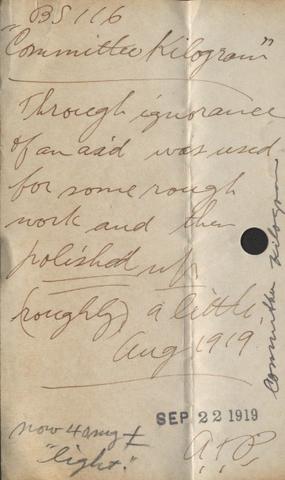A Weighty Mistake

The note reads, “Through ignorance of an aid [sic] was used for some rough work and then polished up (roughly) a little. Now 40mg ‘light.’ ”
The kilogram is getting a lot of attention lately. From the divergence between the mass of the international and national prototypes to the convergence of recent experiments redefining the kilogram in terms of Planck’s constant, the days of using a chunk of metal to fix mass are numbered. It seems that America’s national kilogram prototype, K20, is destined for white-glove treatment in the NIST Museum—where it will doubtless be cooed over for its historical significance.
Or is it?
If history is to repeat itself, K20 needs to prepare itself for a little “rough” handling before it can enjoy retirement in the NIST Museum. That might sound ridiculous for an artifact that merited a party at the White House when it first entered our country along with the national prototype meter in 1890. After all, it was considered a triumph of international collaboration and served as a touchstone of U.S. metrology for 125 years (and counting).
But what if I told you that K20 is not the earliest kilogram in NIST’s possession that could claim this level of historical import? Indeed, it could be argued that the “Committee Kilogram” of 1799 has a much more interesting provenance. Imagine, then, our surprise upon discovering the note shown at right wedged in the kilogram’s case in the NIST Museum.
Handled in ignorance, used for rough work, poorly polished, and ultimately finding itself 40 milligrams lighter, the Committee Kilogram had itself a pretty bad day in August of 1919. The NBS aide who mishandled it probably had a worse one. You can imagine Arthur Pienkowsky, then head of the NBS Mass Section, giving the aide a bit of a history lesson, if not a sound talking-to.
The Committee Kilogram is the moniker for this historical standard of mass that made its way to the United States some six years after it was fabricated according to specifications set out by a 1798-1799 international conference on the metric system. If you’re a history buff, you will recognize that this is the same conference that originally defined the meter to be one ten-millionth of the distance between the North Pole and the equator, that distance having been established by an ambitious survey by Jean Baptiste Joseph Delambre and Pierre Méchain. The kilogram in turn was derived from this unit of length—i.e., the mass of a decimeter cube of distilled water at 4 degrees Celsius. The two units were intended to be a matched set, providing a rational basis of metrology the world-over.
The attendees of the international conference were to go forth with the small number of meter bars and kilograms that had been made and become metric crusaders. Clearly the dissemination of these standards was intended to play out on an international field, but our Committee Kilogram really went the distance when it jumped the puddle. That’s remarkable considering the U.S. did not even have a representative at the conference.
The fact that the Committee Kilogram (and its sibling meter) crossed the Atlantic in the hands of Ferdinand Rudolph Hassler (1770-1843), a Swiss émigré known for both his scientific prowess and his colorful personality, add significantly to the origin story of this artifact. Hassler purportedly obtained the metric set from his friend (and conference attendee) Johann Trallès sometime before setting sail for the United States. Hassler had big plans to establish a Swiss colony in the South, but his business partner speculated the money away before Hassler even set foot on our shores.
So, what did Hassler do upon arriving? He sold his valuables. He even hawked the meter and the kilogram to the American Philosophical Society in Philadelphia, a hub of intellectuals who eventually helped Hassler find gainful employment as the head of the U.S. Coast Survey (well, until he was canned and then rehired years later, but that is another story). The metric standards made their way back into Hassler’s possession when he commenced the survey, and followed him to the Treasury Department’s Office of Weights and Measures when he became the first superintendent of that new federal entity in 1836.
Born from what some have claimed to be the first international scientific conference, carried to our country by a rock star of metrology, and used to extract money from Philadelphia’s intelligentsia, the Committee Kilogram has every right to be offended by the rough handling it received in 1919. Maybe it can console itself by the fact that it was used (if not lovingly) for more than 120 years. The Committee Kilogram will have a great story to convey to our current prototype, K20, when the latter eventually makes its way into our historical collection.
Originally published in NIST Connections: A Newsletter for NIST Employees and Associates, November 2015, p. 4.

